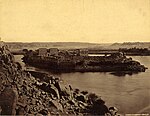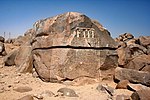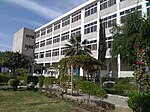Agilkia Island

Agilkia Island (also called Agilika; Arabic: أجيليكا, from Old Nubian: ⲁ̅ⲅⲗ̅, romanised: agil, "mouth") is an island in the reservoir of the Old Aswan Dam along the Nile River in southern Egypt; it is the present site of the relocated ancient Egyptian temple complex of Philae. Partially to completely flooded by the old dam's construction in 1902, the Philae complex was dismantled and relocated to Agilkia island, as part of a wider UNESCO project related to the 1960s construction of the Aswan High Dam and the eventual flooding of many sites posed by its large reservoir upstream.Agilkia, like the island, was the name chosen for the planned landing site on a comet by the Rosetta spacecraft mission's Philae lander. Upon initial touchdown, however, the lander took a large bounce followed by a smaller one before finally coming to rest perhaps a kilometre away from Agilkia, at a site named Abydos, after the ancient Egyptian city.
Excerpt from the Wikipedia article Agilkia Island (License: CC BY-SA 3.0, Authors, Images).Agilkia Island
25,
Geographical coordinates (GPS) Address Nearby Places Show on map
Geographical coordinates (GPS)
| Latitude | Longitude |
|---|---|
| N 24.025277777778 ° | E 32.884166666667 ° |
Address
معبد فيلة (أنس الوجود)
25
81531
Aswan, Egypt
Open on Google Maps





